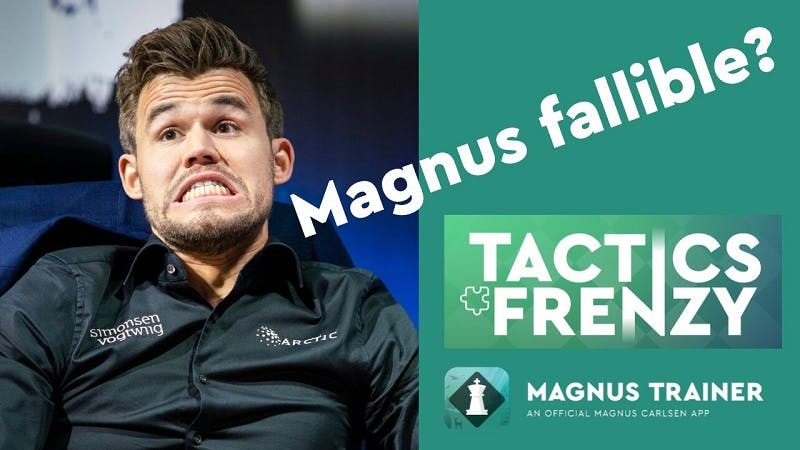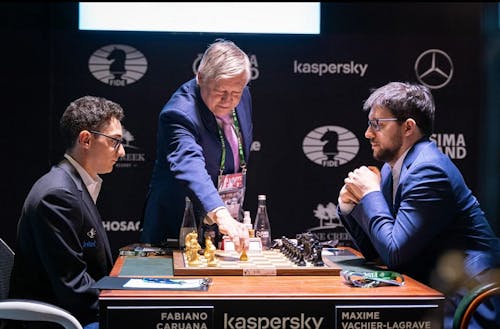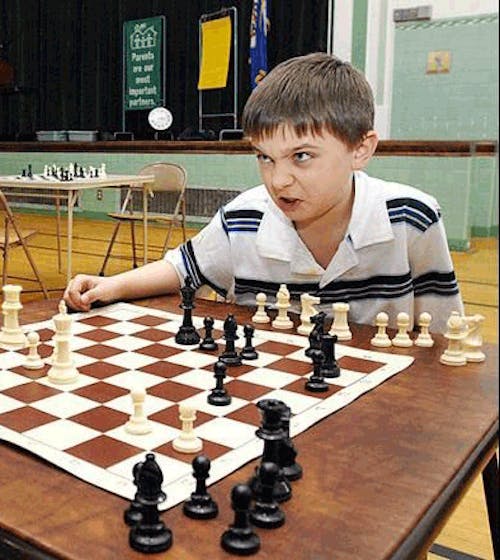Are you sure you want to delete your account?
(This will permanently delete all of your data - purchases, game scores, ratings, etc)
Change your username
Your current username is: guest
Change your account email address
Your current account email is:
Redeem your Fampay code here!
Use your Fampay code to get access to the Play Magnus Plus Membership!

Twelve Fun Ways of Solving Chess Tactics
Are you as happy about your tactics as Magnus is on this image?
What was the saying once again? “Solving tactics every day keeps the blunders away”? Chess is a challenging game, so mistakes are inevitable. Still, enhancing your tactical capabilities can drastically improve your performance over the board by reducing your blunder rate and allowing you to capitalize on your opponent’s oversights.
However, if you are serious about your chess training and keep following this advice day by day, at some point, you might get bored. Just like you need to surprise your body by changing the gym training routine after a certain period, you may want to try something new to get your brain excited and fresh.
Let’s go over several different ways you can train tactics.
Standard mode. Feel free to take as long as you want to solve the puzzle. What matters is that you get it right in the end. If you are using an app such as our beloved Tactics Frenzy, the process is straightforward. When it comes to books, make sure to write down your solutions and check them carefully. Otherwise, it is tempting to peek into the answer page and to say: “Yes, I saw that idea!” even if your move order was wrong or you weren’t sure which option to pick in the end.
Rated mode. When solving puzzles from books or newspapers, it is hard to keep track of your performance and see whether you are making any progress. Apps/online tools/software are better in the sense of allowing you to monitor such data, as well as other vital statistics, such as time spent, the number of puzzles solved, and so on. Just don’t be too hard on yourself rating-wise. Remember that things take time!
Timed mode. Depending on the difficulty of the puzzle, give yourself a fixed amount of time to tackle it. When the time runs out, you have to make the best move in the position as if it were a real game. The objective is to find the solution, but even if you don’t get it right, check how good your continuation was. Was it a neutral move, or did you blunder something? Analyze the position and realize what went wrong in your thinking process.
Cooperative mode. You can try this with a training partner or even as a group. Take on relatively complex puzzles, discuss them together, come up with surprising suggestions, refute each other’s analysis, or build upon it. It is always interesting to get to know how other people approach specific chess positions. Hopefully, eventually, you will arrive at the solution. Even if not, the way you all agreed to something dead stupid also provides for a lot of chess entertainment – trust us, we have been there many times!
Competition mode. Whereas the “cooperative mode” is better suited for developing teamwork skills, the “competition mode” was prevalent in the USSR, where the emphasis in school studies was on excelling individually. You can take on a series of puzzles with your training partner(s), all on your own, and see who performs better in the end! It will be interesting to discover whether your brain functions better or worse under such extreme conditions.

You don’t have to wear a blindfold for this mode, but you score extra style points for doing so!
Blindfold mode. This one is for advanced players. Take a careful look at the position, memorize it and then try to work out the solution in your head. For even more advanced players, you can combine it with the distraction mode (see below).
Distraction mode. If it is hard for you to focus during the game, you may want to make life even more challenging for yourself while training. Combine solving chess puzzles with other activities, such as doing squats, running, cooking, talking, etc. Just make sure your milk doesn’t boil over! Bonus points for streaming the process and getting new subscribers/donations this way.
Practice mode. This one can be done against a training partner or an engine. Approach the starting position of a puzzle as if it were a real game. Play it out and see what the outcome is going to be. Quite often, people focus purely on landing spectacular tactical strikes to realize they don’t have the technique to convert their advantage later on in the game. This method works particularly well for complex positions where both sides have tactical resources.
Test mode. Take on a series of puzzles to determine how sharp you are tactically. Usually, the author(s) of the test will let you know the conditions and goals, so you will be aware how to handle the task.
Woodpecker mode. The idea of this method is to automate your pattern recognition by solving a series of puzzles repetitively until you can cruise through them on autopilot. In a nutshell, you try to solve the exercises as well and quickly as you can. After a certain amount of time passes, you repeat the cycle, trying to improve your results both timewise and performance-wise. You can read about this approach in more detail in the book “The Woodpecker Method” by Grandmasters Axel Smith and Hans Tikkanen.
Do-it-yourself mode. One way of maturing into an even more sophisticated tactician involves creating your chess puzzles and making sure there are no loopholes in the solutions. You don’t necessarily have to become a chess composer and take part in chess composition contests (are you aware of their existence, by the way?), but devising some devious puzzles and sharing them with your friends can be very fulfilling. Make them sweat!
Bait (“Jebaited”) mode. A severe drawback of allocating too much time to traditional puzzle-solving is that you may start disrespecting the opponent’s resources and sacrificing pieces left and right, assuming that if there is a tactical motif in the position, then it will always work out in your favor. However, in real games, flashy combinations are quite often refuted by even more mind-blowing counterstrikes.
Therefore, it is helpful to takes on series of tactical exercises where some of the puzzles provoke you into falling for incorrect combinations and getting punished for doing so. This mode is a good reminder that real-life opponents are more than a punching bag that takes all your hits and never complains.
Feel free to experiment with the methods suggested above and see which ones you like most! Or, even better, come up with new tactics training ideas.
Solved a fantastic puzzle? Discovered a revolutionary training method? Don’t forget to share your passion with others on social networks using the hashtag #TacticsFrenzy!

